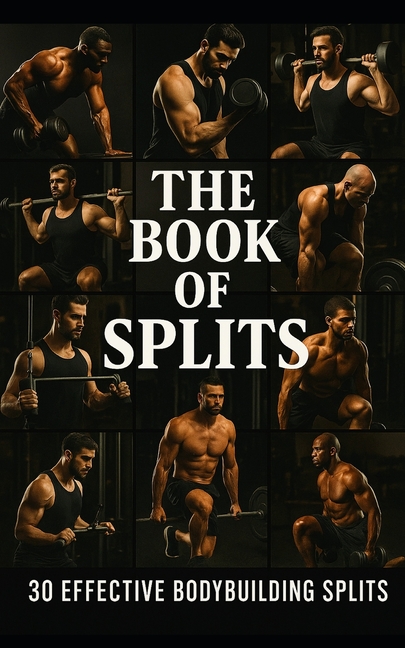Description
The Book of Splits delivers 30 battle-tested training programs for lifters who've plateaued on traditional routines. This book is designed for serious lifters ready to do the work.
Chapter 1: Peripheral Heart Action (PHA) Training
Full-body split alternating upper/lower movements with minimal rest to jack up hypertrophy and conditioning.
Chapter 2: Escalating Density Training (EDT)Push volume over time using 15-20 min blocks per muscle group.
Chapter 3: Myo-RepsRest-pause activation sets with 3-5 clustered mini-sets. Example: push/pull/lower split with myo-style volume.
Chapter 4: 11/2 Rep MethodTrain the full ROM with overload on sticking points. Chest and legs respond especially well. Example: chest day with 11/2 rep bench press and flys.
Chapter 5: Mechanical Drop SetsShift grip or stance mid-set. Ex: incline → flat → decline dumbbell presses.
Chapter 6: Blood Flow Restriction (BFR)Arms/lower body focus with light loads. 5-day arm specialization split included.
Chapter 7: Zone TrainingSplit reps into thirds; overload top, middle, or bottom zone of the lift. Great for stubborn areas.
Chapter 8: Wave LoadingAlternate reps and weights in waves (e.g., 6/4/2) for CNS shock and strength gains.
Chapter 9: Giant Sets4+ exercises per muscle group. Example: back day with lat pulldown, row, pullover, and deadlift giant set.
Chapter 10: Tri-SetsThree exercises in a row for the same muscle. Push-pull-legs tri-set programming guide.
Chapter 11: Drop LaddersDrop weight but increase reps-classic shock tactic. Use for delts and arms.
Chapter 12: Intraset StretchingStretch mid-set for 10-20 sec. Great on pecs, lats, and hammies.
Chapter 13: Antagonist SupersetsPair bi/tri, chest/back, quads/hams. Full-body antagonist split included.
Chapter 14: Time-Under-Tension (TUT)Slow tempo work (e.g., 4-1-2-1). 4-day tempo-focused hypertrophy split.
Chapter 15: Rest-Pause Cluster SetsMini rests to squeeze more quality reps. Example: cluster bench press with 20 sec between reps.
Chapter 16: Accentuated Eccentric TrainingHeavy negatives for growth and joint integrity. Back and legs benefit most.
Chapter 17: Compound-After-Isolation (Pre-Fatigue Reversal)Example: leg extensions → squats, flys → bench. 5-day pre-fatigue split.
Chapter 18: Concentric-Only TrainingExcludes eccentric phase for recovery. Example: sled push + trap bar deadlift plan.
Chapter 19: 21sClassic biceps protocol; use for other muscle groups too. Arms and shoulders blast split.
Chapter 20: Iso-Dynamic ContrastIsometric hold → explosive reps. Power-bodybuilding plan included.
Chapter 21: Density BlocksSet a timer and go. Chest/back density day program included.
Chapter 22: Zone-Specific Failure SetsTrain only top or bottom of ROM to failure. 3-day specialization split.
Chapter 23: Occlusion + Mechanical Drop HybridAdvanced arm protocol combining BFR and grip changes.
Chapter 24: High-Rep FinishersEnd with 50-100 total reps. Adds volume safely. Great for delts and calves.
Chapter 25: Load-Variation CircuitsCycle heavy/light within circuits. Total-body strength-hypertrophy hybrid.
Chapter 26: Isometric Pre-TensionHold the rep at midpoint to increase neural tension. Shoulder and chest example workouts.
Chapter 27: Yielding IsometricsHold a heavy weight statically under tension. Deadlift holds, squat bottom holds.
Chapter 28: Overload Partial RepsTrain only the strongest portion of the movement (e.g., top half rack pulls).
Chapter 29: "Every Minute on the Minute" (EMOM) LiftingStrength-density hybrid. Full week EMOM split for hypertrophy and volume.
Chapter 30: Undulating Daily Periodization (Auto-Wave)Change reps/weights daily. Push/pull/legs weekly wave cycle included.
Product Details
- Jun 23, 2025 Pub Date:
- 9798289363664 ISBN-10:
- 9798289363664 ISBN-13:
- English Language




